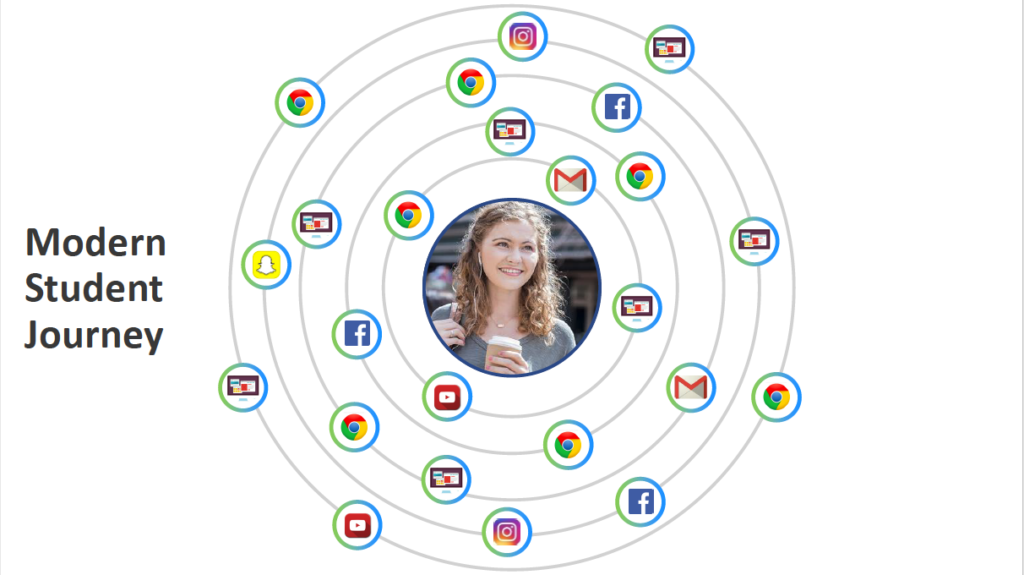By Mary DeLuca, Vice President
You can’t communicate effectively to someone you don’t understand. Yet, too often, colleges launch communications without first considering what matters to their audiences. Take teens, for example. Convincing them to come to your college when they graduate high school is not likely to happen if you don’t first understand them.
What do we know about today’s teens? A lot, actually. Part of the Gen Z generation, they grew up surrounded by tech. Their perspective has been shaped by helicopter parents, mass shootings, and now a global pandemic. Not surprisingly, mental health is the number one issue many members of Gen Z express facing. They’re also the most diverse generation, and a socially conscious group, growing up in a time of economic, political, and social change.

So, if you want to move more of them to see themselves at your college, you need to first view your outreach through their college decision-making lens. Here are five ways to do that as you work to increase your market share of high school graduates for Fall 2021 and beyond.
1. Engage them earlier.

In focus groups Interact conducts with high school students across the nation, teens tell us they rarely hear from colleges until their junior year. Then, during senior year, they are inundated with college ads. Feeling overwhelmed, they tend to tune out everything. What would they prefer? They say it would be better to reach out to them earlier in their high school years—or even in middle school. They would especially welcome information about opportunities to earn college credits while still in high school, which many say they don’t discover until their senior year, which is too late.

This feedback is in line with what we also know about the student journey, which is long—more than a year for most—and fragmented. In fact, Google data indicates there are more than 3,000 touch points in a typical student journey. What’s more, the data shows there are only 4 colleges in a student’s initial consideration set. And 75 percent of students never consider any colleges beyond their initial set.
So, you need to be there at the beginning, when they’re first contemplating college. And you need to create micro-moments with them along the way. If not, you’re unlikely to ever regain their consideration.
2. Address their biggest fears and desires.

Being a teen has never been easy. But for today’s teens, the pressure is even more intense: to get more likes on Instagram, to do well in school, to be healthy, to be more self-reliant, to have the latest tech, to make money, to define what they stand for, and to drive change in society. Those pressures would weigh heavily on anyone, particularly at such a young age.
How can you help them? Be a trusted resource. Guide them with what they want to know about college:
- how they can afford to pay for college and all of the related expenses
- what programs fit their interests and build a foundation for their future stability
- how going to college will change their lives
Empower them to make informed decisions. You have an advantage here, as they care about expertise. Your faculty have this. They want hands-on experience that will make them work-ready. No sector of higher ed does this better than community and technical colleges. And they face college tuition that has become staggeringly unaffordable. You can help them cut their costs considerably, and may even enable them to complete their first two years tuition-free.
How can you equip them with this helpful content? Take them to landing pages you design just for them. Your website is typically the first place they go searching for advice on careers, programs, and how to apply for scholarships. Be sure you use these online hubs to connect them to your social pages, too, as they look at your social content to get a better feel for your campus and culture. Be there for them. Invite them into the conversation.
3. Be authentic.

This generation sees things much differently than those who are shaping college decisions. For Boomers, college was a choice. You could be successful with or without a degree. For Millennials, college was something you aspired to and was more a question of where you could afford to go. For Gen Z, college is no longer the default option for getting a good education and launching a career. Gen Z is fearful of the implications and looking for their own path to success.
So saying you’re great won’t cut it. Prestige means less. Trust and feeling understood means everything. Communicate value by signaling you really get them. They say that they listen to, but actually do not completely trust what most adults have to say about college, simply because they believe that they are out of touch with their issues and fears.
So who and what can convince them? Unscripted messages from their slightly older peers are the strongest messages. They are highly resistant to general messaging. They want specifics about what the college experience will be like, if the programs they want are available, and how they’ll be able to afford it. Use this as an opportunity to engage them in meaningful conversations with your current students. Invite them to events (virtual now, in-person later) where your student ambassadors can share their warmth, energy, and pride. Include your mascot, if you have one. Connect them with student groups and organizations who share their interests—perhaps academic, athletic, or artistic. Have student social media takeovers. Ask your students to post video testimonials. And feature what your students have to say about their experiences on your website, in your social media, and in your recruitment publications.
4. Don’t overlook direct mail.

Our high school student focus groups admit they have a hard time keeping up with the emails they receive from colleges, as this tends to be the main mode of recruitment outreach, especially by senior year. They also indicate they find direct mail more appealing as they rarely receive any in this era of virtual everything.
So, while you’re continuing to meet them where they are on social media, namely Instagram, YouTube, and Snapchat—still their favorites—be thoughtful about your direct mail approach. Direct mail is in the “top three” recruiting methods teens responding to Interact’s Media Prefs survey coast-to-coast believe have the most impact on them. The only two rated as more impactful are recruiter visits to their high schools (unlikely now), and campus visits/tours, which can be engaging as long as you step up your authenticity and interactivity.
Now may be the perfect time to rethink your high school viewbook strategy, as well. Instead of a one-and-done approach that goes out to seniors, think about their student journey and what will be useful to their decision making as freshmen, sophomores, juniors, and then seniors. Develop a direct mail series that shows you understand them and are a trusted resource at each step along the way. Let their peers who came before them speak for you. Use messages and images that depict the true you. Guide them to content you’ve customized for them on your website. And, don’t forget that for Gen Z, communication is all about being efficient. Perhaps scrap the complex sentence now and then for an emoji or two.
5. Remember their influencers.

Finally, don’t forget they’re still young and impressionable, especially when it comes to what their parents, teachers, and counselors think and say. Disappointingly, Interact’s researchers hear way too often from high school students how all three of these influencer groups push them to apply to four-year schools and only use community colleges as a “fallback” position, especially in more affluent areas.
In less affluent areas, students indicate that while they may be encouraged to try community colleges first, it’s still seen as a means of transferring to a four-year school. Attending a community college to secure valued workplace credentials through career and technical education paths that may lead more quickly to essential jobs and steady income is largely ignored. Clearly, we have a lot of educating to do among teen influencers to ensure they are guided properly.
For high school students to get excited about the doors that a two-year college can open for them, they need their parents, teachers, and counselors to see that potential, too. They need to not only understand but believe in the value of a community college education. That’s where your public relations work comes into play. Find those opportunities to tell your story wherever these influencer groups gather, online and in person. Change the narrative for these Millennials and Boomers, so they, too, celebrate community colleges as the smart choice for all to prepare for in-demand careers that provide a rewarding life, without being saddled with decades of debt.
Want some extra support with your outreach efforts? We’re always happy to help. Set up a free consultation, or check out our services to learn more!
Sources/Credits:
Mark Mastej, Lead Research and Communications Analyst, Interact Communications
Erin Green, ReachLocal Director, DMS Enablement, who presented with Google in a special webinar Interact hosted earlier in 2020
Glacier Q2 Virtual Roundtable eBook https://drive.google.com/drive/folders/1Kviwu-qZAajIOQdyluW35fJ3wD3eN1hQ
http://www.businessinsider.com/forget-millennials-here-are-8-things-to-know-about-gen-z-2017-7



